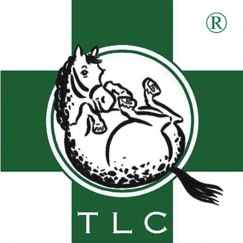Laminitis
cases
These show a lameness by being reluctant to move, taking the weight on their heels
and shifting their weight from one foot to another, constantly. They also have
bounding digital pulses. Laminitis cases uncomplicated by an underlying medical
problem should be much better within a few days if given the treatments which
we recommend. Nevertheless I strongly suggest that they remain confined to their
stables for at least a month after they appear sound without painkillers. The
reason for this is that the laminae are still inflamed and have lost some of their
strength. Premature exercise can induce these cases to founder. Even mild exercise
can do this; such as allowing the horse to mooch around a barn or menage.However
cases which do have an underlying problem such as Cushing's disease, metabolic
syndrome or those which have been given corticosteroids have a much more guarded
prognosis. Some of these do not respond to treatments, continue to be lame or
become more lame and have to be put down.
Acute
founder cases
These show the same symptoms as laminitis cases but also have palpable depressions
above their coronary bands on the affected feet. These depressions usually, but
not always, first appear at the front of the coronary band. The deeper and wider
the depression the worse the founder i.e. the more the pedal bone has dropped
within the hoof. Accurately measuring the founder distance from X-rays gives an
accurate prognosis. For example a true founder distance of 15 mm or more is bad
news and I rarely attempt treatment of such cases. The depth of the supra-coronary
depressions is highly correlated with the founder distance so that regular monitoring
of the depressions gives an excellent idea of whether the horse is continuing
to founder. All acute
founder cases should be given a year's rest if they are to be achieve optimal
soundness. This means at least four months box rest. Thereafter confinment to
a yard or barn may be appropriate. Acute founder cases need corrective shoeing,
sympathetically and regularly applied every five weeks. They may well need dorsal
wall resections, specific treatments of tubbing should the develop foot abscesses
and may need surgical treatments should they develop deep digital muscle contracture.
Sinkers
Sinkers do not show the same type of lameness as laminitis or acute founder cases.
Sinkers are very reluctant to move. They have bounding digital pulses and sometimes
stone cold feet. They do not try and stand on their heels; they stand flat footed.
Sinkers have supra-coronary depressions which extend the full length of the coronary
band on the affected feet. That is, from one heel all the way around the front
of the coronary band and back to the other heel. Remember only 20% of sinkers
can be expected to recover, again the founder distance is a significant prognostic
indicator. If you are successful at treating a sinker it should be given one year
of rest just like an acute founder case.
Chronic
founder cases
We need to distinguish here between chronic founder cases which are lame because
they have distorted feet and those which also have laminitis. The former can usually
be treated successfully, at least to greatly improve their lameness by corrective
foot dressing and shoeing. This involves using the principles of rasping off any
long toes to restore the parallel relationship between the front of the hoof wall
(or what is left of it) and the front of the pedal bone [This can be checked
by taking X-rays if necessary]; and lowering the heels to restore a straight
phalangeal axis. Most chronic founder cases are more comfortable if they are shod
(to lift their soles off the ground) with well seated out shoes with sufficient
length and width at the heels. However, be aware of the possibility of deep digital
flexor contracture in chronic founder cases and emply of toe-wedge test before
starting any foot dressing if there is any doubt. Additionally chronic founder
cases which have lost large amounts of pedal bone mass will never be sound; there
is not sufficient laminal surface area left to support the horse within its hooves.
Without these two complications these cases can be improved within one or two
shoeings so that they may return to ridden work. Many go into the forge lame and
come out pretty sound. Chronic
founder cases which are also suffering laminitis may be more complicated and have
an unpredictable timescale of treatment. This is because many chronic founder
cases do have underlying medical problems. If or until these can be treated little
or no improvement in lameness can be expected. In addition to the usual laminitis
treatments chronic founder cases need corrective foot dressing and shoeing to
be done whilst the medical treatments are starting to work.
